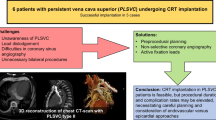Abstract
Persistence of a left superior vena cava (LSVC) has been reported in 0.3%–0.4% of candidates for pacemaker (PM) or cardioverter-defibrillator (ICD) implantation. The aim of the study was to evaluate the clinical implications of LSVC persistence for proper device performance. We observed the prevalence of LSVC during a 15-year period. A total of 2077 consecutive patients underwent PM implantation over a 15-year period: 7 had persistent LSVCs (0.34%). Among 599 patients undergoing ICD implantation, 4 LSVCs (0.66%) were observed. Overall LSVC persistence was found in 11/2676 (0.41%) patients. The right superior vena cava was absent in 4/11 (36%) patients. The leads were placed from the left subclavian approach in 5/7 PM patients: 2 received an elective right sided approach due to physician preference. All ICD patients had the device placed left pectoral with a single-coil lead: defibrillation therapy was effective in the long term in all but one patient, who required the addition of a subcutaneous array. Left superior vena cava persistence in PM/ICD patients is similar to the general population (0.41% in our study). The left-sided implant may be skill-demanding during lead placement; however, this task can be accomplished in the majority of cases, with a reliable outcome in the short term and appropriate device performance at follow-up.
Similar content being viewed by others
References
Los JA (1958) The development of the human pulmonary vein and the coronary sinus in the human embryo. Thesis, University of Leiden
Van Mierop LHS (1969). Embryology of the heart. In: Netter FH (ed) The CIBA collection of medical illustrations, vol 5, pt 1. CIBA Pharmaceutical, Summit, NJ, pp 112–130
Meadows WR, Sharp JT (1965) Persistent left superior vena cava draining into the left atrium without arterial oxygen unsaturation. Am J Cardiol 16:273–279
Krukral JC (1971) Transvenous pacemaker failure due to anomalous venous return to the heart. Chest 59:4584–4561
Garcia L, Levine R, Kosowsky W, Lyon AF (1972) Persistent left superior vena cava complicating pacemaker insertion. Chest 61:396–397
Rubenfire M, Evangelista J, Wajszczuk WJ, Kantrowitz A (1974). Implication of a persistent left superior vena cava in transvenous pacemaker therapy and cardiac hemodynamic monitoring. Chest; 65145–65147
Robbens EJ, Ruiter JH (1986) Atrial pacing via unilateral persistent left superior vena cava. Pacing Clin Electrophysiol 9:594–596
Dirix LY, Kersschot IE, Fierens H, Goethals MA, Van Daele G, Claessen G (1988) Implantation of a dual chamber pacemaker in a patient with persistent left superior vena cava. Pacing Clin Electrophysiol 11:343–345
Zerbe F, Bornakowski J, Sarnowski W (1992) Pacemaker electrode implantation in patients with left superior vena cava. Br Heart J 67:65–66
Rusk PA, Bexton JM, Mc Comb JM (1996) Persistent left-sided and absent right sided superior vena cava complicating pacemaker insertion. Heart 75:413
Brooks R, Jackson G, Mc Govern BA, Ruskin JN (1995) Transvenous cardioverter-defibrillator implantation via persistent left superior vena cava. Am Heart J 129:195–197
Hellestrand KJ, Ward DE, Bexton RS, Camm AJ (1982) The use of active fixation electrodes for permanent endocardial pacing via a left superior vena cava. Pacing Clin Electrophysiol 5:180–184
Biffi M, Boriani G, Bronzetti G, Frabetti L, Branzi A (2001) Left superior vena cava persistence in patients undergoing pacemaker or cardioverter-defibrillator implantation. A 10-year experience. Chest 120:139–144
Movahed MR, Hashemzadeh M, Jamal M (2007) Increased prevalence of ventricular fibrillation in patients with type 2 diabetes mellitus. Heart Vessels 22(4):251–253
Lopez JA (2008) Transvenous biventricular pacing for cardiac resynchronization therapy in patients with persistent left superior vena cava and right superior vena cava atresia. Tex Heart Inst J 35(1):54–57
Boriani G, Artale P, Biffi M, Martignani C, Frabetti L, Valzania C, Diemberger I, Ziacchi M, Bertini M, Rapezzi C, Parlapiano M, Branzi A (2007) Outcome of cardioverter-defibrillator implant in patients with arrhythmogenic right ventricular cardiomyopathy. Heart Vessels 22(3):184–192
Epstein AE, Kay GN, Plumb VJ, Voshage-Stahl L, Hull ML (1995) Elevated defibrillation threshold when right-sided venous access is used for nonthoracotomy implantable defibrillator lead implantation. The Endotak investigators. J Cardiovasc Electrophysiol 6:979–986
Favale S, Bardy GH, Pitzalis MV, Dicandia ICD, Traversa M, Rizzon P (1995) Transvenous defibrillator implantation in patients with persistent left superior vena cava and right superior vena cava atresia. Eur Heart J 16:704–707
Markewitz A, Mattke S (1996) Right ventricular implantable cardioverter defibrillator lead implantation through a persistent left superior vena cava. Pacing Clin Electrophysiol 19:1395–1397
Paperini L, Pardini E, Genovesi Ebert A, Galli M (2004) Transvenous cardioverter-defibrillator implantation with a double-coil lead via left persistent vena cava. Ital Heart J 5:711–713
Leng CT, Crosson JE, Calkins H, Berger RD (2001) Lead configuration for defibrillator implantation in a patient with congenital heart disease and a mechanical prosthetic tricuspid valve. Pacing Clin Electrophysiol 24:1291–1292
Tokano T, Pelosi F, Flemming M, Horwood L, Souza JJ, Zivin A, Knight BP, Goyal R, Man KC, Morady F, Strickberger SA (1998) Long-term evaluation of the ventricular defibrillation energy requirement J Cardiovasc Electrophysiol 9(9):916–920
Higgins SL, Rich DH, Haygood JR, Barone J, Greer SL, Meyer DB (1998) ICD restudy: results and potential benefit from routine predischarge and 2-month evaluation. Pacing Clin Electrophysiol. 21(2):410–417
Shukla H, Flaker H, Jayam V, Roberts D (2003) High defibrillation thresholds in transvenous biphasic implantable defibrillators: clinical predictors and prognostic implications. Pacing Clin Electrophysiol 26(1 Pt 1):44–48
Author information
Authors and Affiliations
Corresponding author
Rights and permissions
About this article
Cite this article
Biffi, M., Bertini, M., Ziacchi, M. et al. Clinical implications of left superior vena cava persistence in candidates for pacemaker or cardioverter-defibrillator implantation. Heart Vessels 24, 142–146 (2009). https://doi.org/10.1007/s00380-008-1091-4
Received:
Accepted:
Published:
Issue Date:
DOI: https://doi.org/10.1007/s00380-008-1091-4




